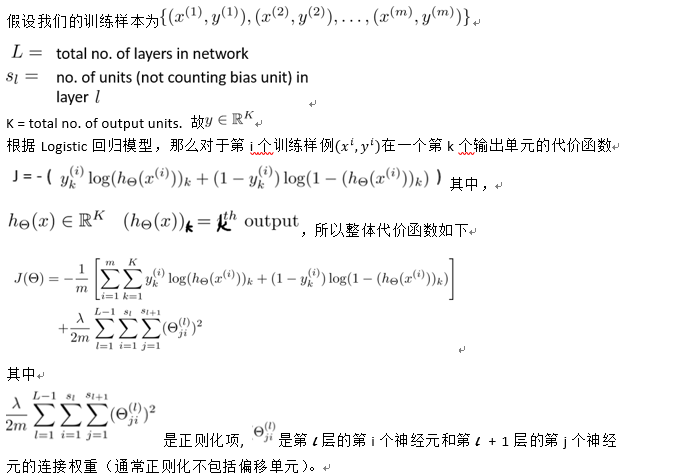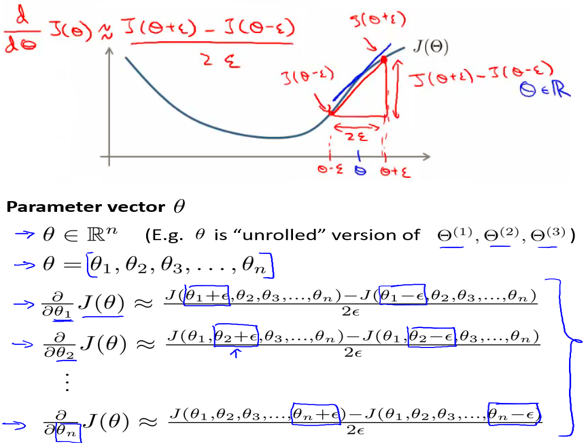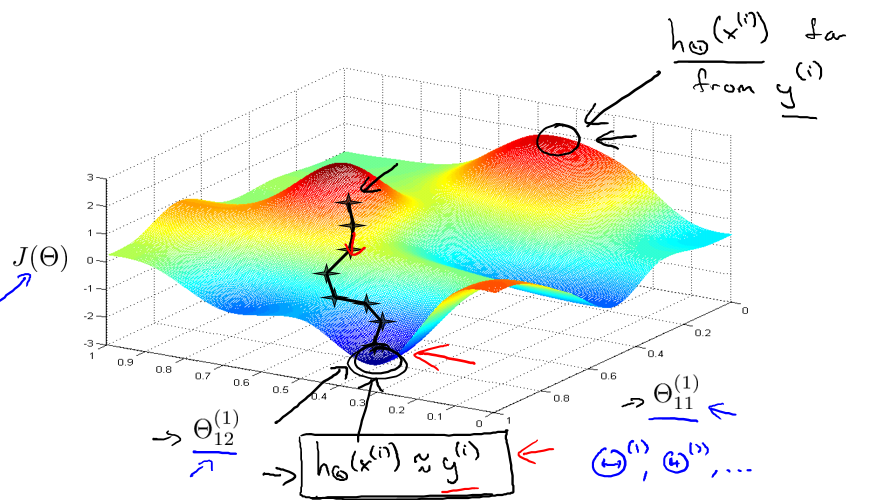5 Neural Networks (part two)
content:
5 Neural Networks (part two)
5.1 cost function
5.2 Back Propagation
5.3 神经网络总结
接上一篇4. Neural Networks (part one). 本文将先定义神经网络的代价函数,然后介绍逆向传播(Back Propagation: BP)算法,它能有效求解代价函数对连接权重的偏导,最后对训练神经网络的过程进行总结。
5.1 cost function

(注:正则化相关内容参见3.Bayesian statistics and Regularization)
5.2 Back Propagation

(详细推导过程参见反向传播算法,以及李宏毅的机器学习课程:youtube,B站)。

图5-1 BP算法步骤
在实现反向传播算法时,有如下几个需要注意的地方。
- 需要对所有的连接权重(包括偏移单元)初始化为接近0但不全等于0的随机数。如果所有参数都用相同的值作为初始值,那么所有隐藏层单元最终会得到与输入值有关的、相同的函数(也就是说,所有神经元的激活值都会取相同的值,对于任何输入x 都会有:
 )。随机初始化的目的是使对称失效。具体地,我们可以如图5-2一样随机初始化。(matlab实现见后文代码1)
)。随机初始化的目的是使对称失效。具体地,我们可以如图5-2一样随机初始化。(matlab实现见后文代码1) - 如果实现的BP算法计算出的梯度(偏导数)是错误的,那么用该模型来预测新的值肯定是不科学的。所以,我们应该在应用之前就判断BP算法是否正确。具体的,可以通过数值的方法(如图5-3所示的)计算出较精确的偏导,然后再和BP算法计算出来的进行比较,若两者相差在正常的误差范围内,则BP算法计算出的应该是比较正确的,否则说明算法实现有误。注意在检查完后,在真正训练模型时不应该再运行数值计算偏导的方法,否则将会运行很慢。(matlab实现见后文代码2)
- 用matlab实现时要注意matlab的函数参数不能为矩阵,而连接权重为矩阵,所以在传递初始化连接权重前先将其向量化,再用reshape函数恢复。(见后文代码3)

图5-2 随机初始化连接权重

图5-3 数值方法求代价函数偏导的近似值
5.3 神经网络总结
第一步,设计神经网络结构。

隐藏层单元个数通常都是不确定的。
一般选取神经网络隐藏层单元个数的几个经验公式如下:

参考https://www.zhihu.com/question/46530834
此外,MNIST手写数字识别中给出了以不同的神经网络结构训练的结果,供参考
第二步,实现正向传播(FP)和反向传播算法,这一步包括如下的子步骤。

第三步,用数值方法检查求偏导的正确性

第四步,用梯度下降法或更先进的优化算法求使得代价函数最小的连接权重

在第四步中,由于代价函数是非凸(non-convex)函数,所以在优化过程中可能陷入局部最优值,但不一定比全局最优差很多(如图5-4),在实际应用中通常不是大问题。也会有一些启发式的算法(如模拟退火算法,遗传算法等)来帮助跳出局部最优。

图5-4 陷入局部最优(不一定比全局最优差很多)
代码1:随机初始化连接权重

function W = randInitializeWeights(L_in, L_out) %RANDINITIALIZEWEIGHTS Randomly initialize the weights of a layer with L_in %incoming connections and L_out outgoing connections % W = RANDINITIALIZEWEIGHTS(L_in, L_out) randomly initializes the weights % of a layer with L_in incoming connections and L_out outgoing % connections. % % Note that W should be set to a matrix of size(L_out, 1 + L_in) as % the column row of W handles the "bias" terms % W = zeros(L_out, 1 + L_in); % Instructions: Initialize W randomly so that we break the symmetry while % training the neural network. % % Note: The first row of W corresponds to the parameters for the bias units % epsilon_init = sqrt(6) / (sqrt(L_out+L_in)); W = rand(L_out, 1 + L_in) * 2 * epsilon_init - epsilon_init; end
代码2:用数值方法求代价函数对连接权重偏导的近似值

function numgrad = computeNumericalGradient(J, theta) %COMPUTENUMERICALGRADIENT Computes the gradient using "finite differences" %and gives us a numerical estimate of the gradient. % numgrad = COMPUTENUMERICALGRADIENT(J, theta) computes the numerical % gradient of the function J around theta. Calling y = J(theta) should % return the function value at theta. % Notes: The following code implements numerical gradient checking, and % returns the numerical gradient.It sets numgrad(i) to (a numerical % approximation of) the partial derivative of J with respect to the % i-th input argument, evaluated at theta. (i.e., numgrad(i) should % be the (approximately) the partial derivative of J with respect % to theta(i).) % numgrad = zeros(size(theta)); perturb = zeros(size(theta)); e = 1e-4; for p = 1:numel(theta) % Set perturbation vector perturb(p) = e; % Compute Numerical Gradient numgrad(p) = ( J(theta + perturb) - J(theta - perturb)) / (2*e); perturb(p) = 0; end end
代码3:应用FP和BP算法实现计算隐藏层为1层的神经网络的代价函数以及其对连接权重的偏导数

function [J grad] = nnCostFunction(nn_params, ... input_layer_size, ... hidden_layer_size, ... num_labels, ... X, y, lambda) %NNCOSTFUNCTION Implements the neural network cost function for a two layer %neural network which performs classification % [J grad] = NNCOSTFUNCTON(nn_params, hidden_layer_size, num_labels, ... % X, y, lambda) computes the cost and gradient of the neural network. The % parameters for the neural network are "unrolled" into the vector % nn_params and need to be converted back into the weight matrices. % % The returned parameter grad should be a "unrolled" vector of the % partial derivatives of the neural network. % % Reshape nn_params back into the parameters Theta1 and Theta2, the weight matrices % for our 2 layer neural network:Theta1: 1->2; Theta2: 2->3 Theta1 = reshape(nn_params(1:hidden_layer_size * (input_layer_size + 1)), ... hidden_layer_size, (input_layer_size + 1)); Theta2 = reshape(nn_params((1 + (hidden_layer_size * (input_layer_size + 1))):end), ... num_labels, (hidden_layer_size + 1)); % Setup some useful variables m = size(X, 1); J = 0; Theta1_grad = zeros(size(Theta1)); Theta2_grad = zeros(size(Theta2)); % Note: The vector y passed into the function is a vector of labels % containing values from 1..K. You need to map this vector into a % binary vector of 1's and 0's to be used with the neural network % cost function. for i = 1:m % compute activation by Forward Propagation a1 = [1; X(i,:)']; z2 = Theta1 * a1; a2 = [1; sigmoid(z2)]; z3 = Theta2 * a2; h = sigmoid(z3); yy = zeros(num_labels,1); yy(y(i)) = 1; % 训练集的真实值yy J = J + sum(-yy .* log(h) - (1-yy) .* log(1-h)); % Back Propagation delta3 = h - yy; delta2 = (Theta2(:,2:end)' * delta3) .* sigmoidGradient(z2); %注意要除去偏移单元的连接权重 Theta2_grad = Theta2_grad + delta3 * a2'; Theta1_grad = Theta1_grad + delta2 * a1'; end J = J / m + lambda * (sum(sum(Theta1(:,2:end) .^ 2)) + sum(sum(Theta2(:,2:end) .^ 2))) / (2*m); Theta2_grad = Theta2_grad / m; Theta2_grad(:,2:end) = Theta2_grad(:,2:end) + lambda * Theta2(:,2:end) / m; % regularized nn Theta1_grad = Theta1_grad / m; Theta1_grad(:,2:end) = Theta1_grad(:,2:end) + lambda * Theta1(:,2:end) / m; % regularized nn % Unroll gradients grad = [Theta1_grad(:) ; Theta2_grad(:)]; end
